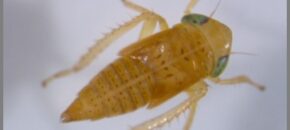New Jersey farms may be interested in adding Cottage Food products to their product line at their farm stands and markets. The Cottage Food Law is very specific about the types of products it covers, the total sales value of the Cottage Food products, and the production location of these products. Municipalities must be consulted […]
Continue reading...Tree Fruit IPM Report for June 1, 2022
Peach: Bacterial Spot: Bacterial spot fruit symptoms started to appear last week statewide. These infections occurred during the mothers day storm. So far levels of fruit infection are very low however we have not yet seen the development of symptoms from recent rain events. Leaf symptoms appear after 1 week and fruit symptoms take 3 […]
Continue reading...Recommendations for Blunt-nosed Leafhopper Management in Cranberries

Blunt-nosed leafhoppers (BNLH) continue to be an increasing threat to cranberries in NJ. BNLH has one generation a year. It overwinters as eggs, which begin to hatch in early May. The nymphs (Picture 1) will go through five instars in about a month. The adults begin to appear by the end of June and are […]
Continue reading...Preparing for important fungal diseases in Asparagus during the summer.
Asparagus growers should consider scouting their fields during the summer months for foliar disease development. Important pathogens that growers need to scout for on a regular basis include Purple spot, Cercospora, and Rust.
Continue reading...Vegetable Disease Update: 5-27-22
Neopestalalotiopsis on strawberry has been reported. Please click here to see the report from Penn State University Extension. Dickeya dianthicola has been reported in potato in Virginia. Botrytis and Anthracnose fruit rot is being reported in strawberry. For more information on controlling these two important diseases please click here. Cucurbit downy mildew has been reported […]
Continue reading...Vegetable IPM Update 5/25/22
Sweet Corn European corn borer (ECB) moths are now being captured in parts of the state. Numbers are low, and no map will appear in this edition. It remains to be seen whether this first flight will amount to much, but recent years’ catches give no reason to suspect that a large population will develop. […]
Continue reading...